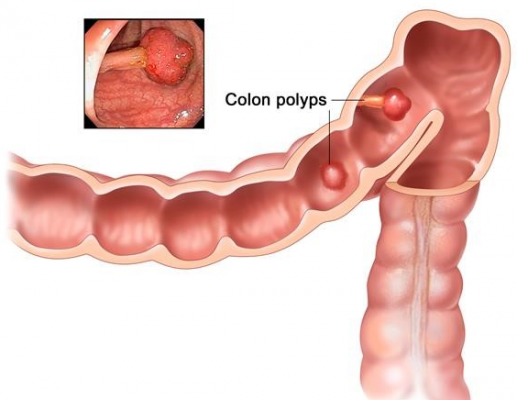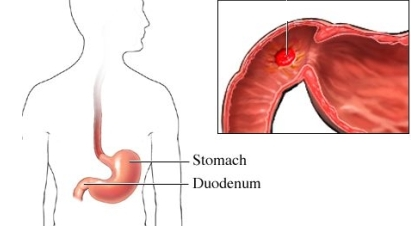Abnormal tissue growth, often resembling small, flat bumps or small fungal stems, is called a polyp. Polyps are benign masses (neoplasms or non-cancerous tumors). These lumps form at different places in the digestive system, but most often, colon polyps occur.
Intestinal polyps

These masses have different sizes and their diameter varies between half a centimeter to several centimeters. Many patients have multiple polyps that are scattered throughout the intestines. Some polyps are also somewhat cancerous, although most polyps are non-cancerous.
Intestinal polyps can be flat or prominent. Prominent intestinal polyps are fungal masses. These polyps look like they are on a stem or root. Flat intestinal polyps look like a carpet of moss. Occasionally, a person can have more than one intestinal polyp.
Cause
Healthy cells grow and divide regularly.
Mutations in specific genes cause cells to continue to divide, even when they do not need new cells. This irregular growth causes the formation of intestinal polyps. Polyps can form in any area of the large intestine and at the end of the large intestine. In general, the larger the polyp, the greater the risk of bowel cancer.
Types of polyps
Intestinal polyps are generally divided into three types: hyperplastic polyps, adenoma polyps, and polyposis syndromes.
Hyperplastic polyps:
These polyps are very common, small and usually less than half a centimeter in diameter. These polyps are generally benign and rarely become cancerous.
Adenoma polyp:
These polyps are also very common. They are often small and less than a centimeter in diameter, but sometimes larger. In rare cases, these polyps become cancerous. If these polyps become cancerous, the change will take several years. Most bowel cancers are caused by a polyp that has been in the bowel for 5 to 15 years(In other words, if most of these polyps are not cancerous, most bowel cancers are usually caused by an adenoma polyp that has been in the bowel for several years.)
It is difficult to accurately diagnose the risk of cancer of an intestinal polyp of the adenoma type. However, the risk of cancer depends on factors such as the size of the adenoma and its exact type. Some subtypes are more susceptible to cancer than others.
Polyposis syndromes:
Polyposis syndromes are a group of inherited diseases. These diseases include the following:
Polyposis, Adenomatosis, Familial (FAP) Hereditary Non-Polyposis Colon Cancer (HNPCC) Lynch Syndrome, Gardner Syndrome, Tourette Syndrome, Putz Jaggers Syndrome, Juvenile Polyposis Syndrome, and Hyperplastic Polyposis. This syndrome is very rare and occurs in young people and often causes a large number of intestinal polyps that are more likely to become cancerous.
Hyperplastic bowel polyps and adenomas are more common. Hyperplastic polyps are not carcinogenic. However, adenoma polyps are said to trigger almost all bowel cancers, although most adenoma polyps never become cancerous. Histology is the best way to differentiate between different types of intestinal polyps. Although it is not possible to determine which adenoma polyps are cancerous, larger polyps are more likely to be carcinogenic (polyps larger than 2.5 cm in diameter). Since the doctor can not give a definite opinion about the type of tissue with the appearance of intestinal polyps, she usually removes all the polyps during the colonoscopy.
Signs
Small polyps of the stomach and intestines are usually asymptomatic and can only be detected during examinations, such as endoscopy or colonoscopy. Symptoms of a polyp include:
Bleeding: This symptom can be a sign of colon polyps or colon and anal cancer.
Stool discoloration: If the polyp is bleeding, the stool will change color depending on the bleeding site. If the bleeding is in the colon and near the anus, the blood is red and streaked, and if the bleeding is in the areas before the colon and anus, the stool will be dark or black.
Stool discoloration: If the polyp is bleeding, the stool will change color depending on the bleeding site. If the bleeding is in the colon and near the anus, the blood is red and streaked, and if the bleeding is in the areas before the colon and anus, the stool will be dark or black.
Stool changes: If diarrhea or constipation lasts for more than a week, it could be a sign of a colon polyp. But there is no definite reason for the existence of polyps.
Pain, nausea or vomiting: If the polyp is large, it can cause obstruction or narrowing of the bowel or stomach, resulting in pain, nausea or vomiting.
Iron deficiency anemia: If the polyp is accompanied by bleeding, the person will develop anemia and iron deficiency due to bleeding. This anemia can cause more complications for the body, such as paleness, fatigue and shortness of breath.
The importance of a polyp depends on the type, whether it is cancerous or not, and the general health of the person. Most benign polyps are usually not a cause for concern, but your doctor may suggest removing them as a precaution.
Possibility of turning benign polyps into cancer Or there is a disturbance in life through infertility caused by uterine polyps or severe nasal mucosa due to nasal polyps.
Polyps are unlikely to recur, but colon polyps recur in 30% of those who have had them removed. Your doctor will tell you what to do after treatment, usually within three to five years.
Bowel polyps are very common in adults and the risk of developing bowel polyps increases with age. Bowel polyps are very rare in people in their 20s, while people in their 60s are estimated to have a 25 percent chance of developing a bowel polyp without specific risk factors. The cause of intestinal polyps is still unknown. Some experts believe that a low-fiber diet and High fat provides the basis for the formation of polyps. Genetic issues can also play a role in the development of polyps.
Treatment of intestinal polyps:
How is a polypectomy performed?
Polypectomy is a procedure performed to remove a polyp from inside the large intestine, or rectum.
In fact, there are several ways in which polypectomy can be performed. The type of procedure depends on the type of polyp in the colon.
The doctor will probably remove all the polyps he finds during the bowel examination. The methods of removing intestinal polyps are as follows:
Colonoscopy
The best way to treat intestinal polyps is to remove them. The doctor will most likely remove the patient’s intestinal polyps during the colonoscopy. The polyps are then examined under a microscope to determine their type or whether they are cancerous. Doctors usually remove the intestinal polyp without surgery.

How to remove a polyp
This method of rectal polyp surgery is relatively non-invasive and is usually performed at the same time as a colonoscopy. In this procedure, a colonoscopy is first performed to detect the presence of a polyp. Colonoscopy is usually done for people over the age of 50 to check for any growths that may indicate cancer. If a doctor discovers a polyp during a colonoscopy, they usually have polypectomy at the same time.
Tissue is examined to determine if the tissue was cancerous, precancerous, or benign. This can prevent colon cancer. Polypectomy also helps relieve these symptoms. This is necessary whenever polyps are discovered during a colonoscopy.
During a colorectal polypectomy, the doctor inserts a tube through the rectum. In this procedure, like a uterine polypectomy, the camera helps the doctor find the polyp.
For small polyps (less than 5 mm in diameter), biopsy forceps can be used to remove them. Larger polyps (up to 2 cm in diameter) can be removed using a trap. In a livestock polypectomy, the doctor loops a thin wire at the bottom of the polyp and uses heat to stop the growth. Then any remaining tissue or stem is cut off.

polypectomy Snare
Some polyps are known to be more challenging for surgery because of their large size, location, or configuration, or are associated with an increased risk of complications. In these cases, endoscopic resection (EMR) or endoscopic (ESD) techniques can be used. In EMR, the polyp is removed from the underlying tissue using fluid injections before
surgery. This fluid injection is often made from saline. Each time a piece of polyp is removed, it is called a piece. In ESD, fluid is injected deep into the lesion and the polyp is removed in one piece.
Intestinal surgery may be needed for some larger polyps that cannot be removed endoscopically.
Laparoscopy
If the polyps are large and cannot be removed by colonoscopy, the patient must have surgery. In most cases, this surgery is performed laparoscopically. This is a minimally invasive surgery that uses a tool called a laparoscope. A laparoscope is a long, narrow tube that emits bright light and has a high-resolution camera on top of it.
The device enters the intestine through an incision in the abdomen. The surgeon removes the polyps with a special tool while examining the patient’s colon. A pathologist, or specialist in tissue analysis, examines polyps for cancer cells.
Gastric polyp

The stomach is an important organ in the body’s digestive system. The stomach, like other parts of the body, is affected by certain disorders. One of these disorders is the presence of polyps in the stomach.
Gastric polyps can be classified according to the size and severity of their symptoms.
The most common gastric polyp is a hyperplastic polyp, which is a small cluster of large glands; This polyp develops in response to inflammation of the lining of the gastrointestinal tract.
Hyperplastic polyps can attach to the stomach wall or endometrium with a stem (base) or without a stem (without a base).
Another polyp is a polyp of the fundus gland, which is located in the upper part of the stomach or fundus. The nature of this polyp is benign and non-cancerous. The third type of polyp is an inflammatory polyp that grows at the junction of the stomach and small intestine.
The most dangerous and malignant polyp is adenomatous polyp. These polyps have a base or no base and are found in cavities (antrum). The nature of these polyps is cancerous and they can grow up to 4 cm in diameter. The presence of adenomatous polyps can be a sign of stomach cancer.
The main cause of gastric polyps is the presence of a special type of bacterium called Helicobacter pylori, which is called H. pylori for short. This bacterium is also known to cause stomach ulcers. Although this bacterium does not cause problems, it can cause infection and inflammation of the lining of the gastrointestinal tract. Another cause of gastric polyps is autoimmune reactions (in which the body’s immune system becomes inactive against tissues and substances in the body) that lead to vitamin B12 deficiency.
Many times, people tend to ignore this stomach problem because the disease does not show any symptoms, pain or discomfort in its early stages. A person only notices gastric polyps when the polyps have become larger and cause pain and discomfort. The severity of gastric polyps is determined by endoscopy and biopsy. A biopsy is a procedure in which a small piece of tissue is removed from an infected area and tested. There are two ways to treat this disease, which are medication and surgery
Antibacterial and antibiotic drugs
If the polyp is caused by the presence of epilator bacteria, your doctor may prescribe antibacterial and antibiotic medications to kill the bacteria in your stomach.
Surgery (polypectomy)
Another treatment is polypectomy, which is a minimally invasive surgery. In this surgery, the lesion is removed from the base; This is done with a special tool that removes polyps from the mucous membrane.

